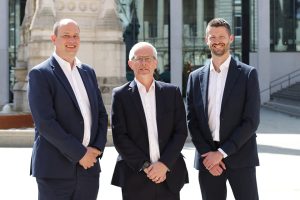The West Midland firm restoring Donald Campbell’s famous Bluebird

FIFTY years on from the death of Donald Campbell in his ill-fated attempt to secure the world water speed record for Great Britain, one West Midlands company is helping with the project to restore his famous vessel, the Bluebird K7.
Campbell was bidding to break his own 276mph water speed record on Coniston Water in Cumbria on January 4, 1967 when the jet-powered hydroplane crashed spectacularly during a high-speed run.
The Bluebird K7, which had already broken seven world records, was bidding to achieve an average speed of 300mph.
As Campbell entered the measured kilometre, however, his unprecedented speed caused the Bluebird’s nose to lift. The craft rose 30ft out of the water, somersaulted and crashed back into the lake, splitting in half on impact. Campbell was killed instantly.
In August 2000 a team led by Bill Smith, an engineer and part-time diver, located the wreckage of the Bluebird. What started out as a project to find the wreck eventually became a large-scale recovery and restoration mission, with the blessing of Donald Campbell’s daughter Gina.
Greg Buxton was a then-employee of industrial materials group, thyssenkrupp, and he knew Mr Smith through their shared passion for diving.
Mr Buxton introduced his employers to the restoration project and they were keen to get involved.

The project aims to restore the wreck of the iconic Bluebird K7 back to its former glory.
Mr Smith said: “We’ve used virtually everything that came out of the lake but we’ve had to reshape what’s available to use and replace some other part. We were just starting out on the restoration when, by chance, Greg got in touch with us. He was eager to help and put us in touch with his colleagues.”
Mr Smith was insistent that donations such as thyssenkrupp’s had allowed the restoration to proceed without the pressure of a fixed deadline, which could have come with other means of funding.
“Every part of this project is achieved through donations – the material, the heat, the light, the premises. It’s hard to find that kind of support, it’s extraordinary,” he said.
“This project goes beyond attention to detail. The idea is that one day you’ll be able to look at archive photos, look at the restored Bluebird and not see the difference.
“If a screw was wonky on the original and we’re putting it back, we won’t try to correct it – we’ll put it in wonky. We’re not working to a deadline. It’s not about getting it done now, it’s about getting it done right.
“The anniversary will come and go as we rebuild the Bluebird but she is a national treasure and we’ll take a long as we need. You can’t display the Bluebird in a museum as a wreck, the chemistry wouldn’t support it. It’d continue to degenerate.
“We’re very thankful for the support of thyssenkrupp and all of the sponsors, donors and volunteers who continue to make this project possible.”
Steady progress is being made on the restoration. A bespoke engine based on the original design has now been fitted, and the Bluebird roared to life in November for the first time since that fateful day in 1967.
Dean Melling, Director of Commercial Materials at thyssenkrupp, said: “This is a fascinating project; we are delighted to be providing material to help support Bill and his team return the Bluebird to its former glory. We are delighted to be associated with a truly unique piece of British history, British history known to many all around the world.
“I’ve been liaising with Bill personally on the project over the last few years and it’s been exciting to watch it progress. We look forward to seeing the Bluebird out on Coniston Water once again someday in the future.”









